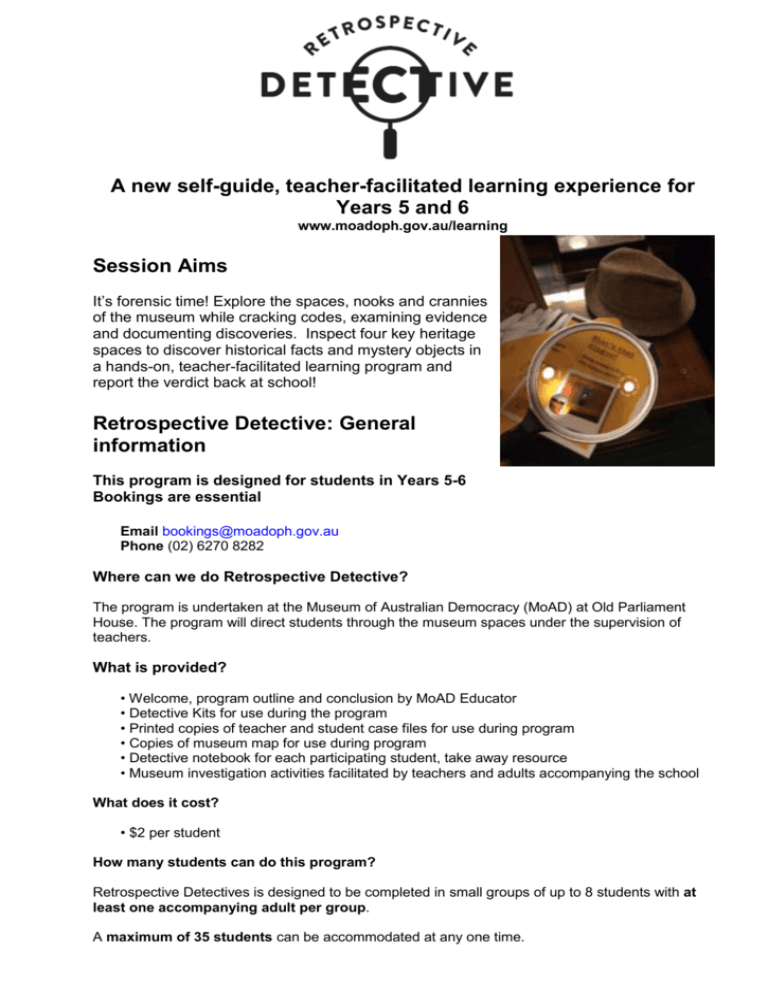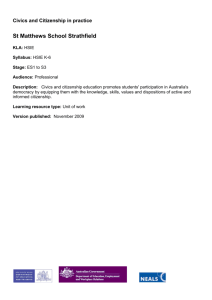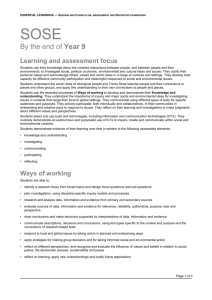Strategies - Museum of Australian Democracy at Old Parliament
advertisement

A new self-guide, teacher-facilitated learning experience for Years 5 and 6 www.moadoph.gov.au/learning Session Aims It’s forensic time! Explore the spaces, nooks and crannies of the museum while cracking codes, examining evidence and documenting discoveries. Inspect four key heritage spaces to discover historical facts and mystery objects in a hands-on, teacher-facilitated learning program and report the verdict back at school! Retrospective Detective: General information This program is designed for students in Years 5-6 Bookings are essential Email bookings@moadoph.gov.au Phone (02) 6270 8282 Where can we do Retrospective Detective? The program is undertaken at the Museum of Australian Democracy (MoAD) at Old Parliament House. The program will direct students through the museum spaces under the supervision of teachers. What is provided? • Welcome, program outline and conclusion by MoAD Educator • Detective Kits for use during the program • Printed copies of teacher and student case files for use during program • Copies of museum map for use during program • Detective notebook for each participating student, take away resource • Museum investigation activities facilitated by teachers and adults accompanying the school What does it cost? • $2 per student How many students can do this program? Retrospective Detectives is designed to be completed in small groups of up to 8 students with at least one accompanying adult per group. A maximum of 35 students can be accommodated at any one time. What do I need to do before the program? Familiarise yourself with the Student’s Case Files, Teacher Intelligence Files and the Program Spaces Map. Session timing The program duration is 90 minutes. The welcome and orientation is facilitated by MoAD Educators. The main body of the program is self-guided, following instructions provided in the Detective Kit. Students visit up to four spaces during this time, undertaking activities in each space. The groups are self-paced and it may not be possible to visit all four spaces during the time available. 25 minutes Welcome and orientation to physical space - facilitated by MoAD Educator 50 minutes Students carry out program activities, working through four ‘Case Files’ that interrogate the building - facilitated by teachers and adults accompanying the school 10 minutes Program debrief – facilitated by MoAD Educator Students depart Learning aims The program engages students in Australia’s ongoing journey as a democracy, in which they have a role, through; Making deductions about significant objects, events and history connected with this former parliamentary building. Questioning and considering: What does this building, its history and objects have to do with me? What relevance do the stories, histories and concepts explored at this site hold for me? What contributions can I make to this site, what meaningful conversations can I with my peers during and after my visit here? Discovering heritage features and their function in the Chambers where Australia’s Federal Parliament met from 1927-1988. Strategies Students will have the opportunity to; Engage in a positive and enjoyable museum learning experience whilst applying knowledge and skills relevant to History, Civics and Citizenship and English. Encounter stories and objects significant to the development of democracy. Engage in collaborative, social learning. Develop museum navigation skills. Develop skills in historical inquiry. Experience the heritage and history of the important and iconic building, Old Parliament House. Curriculum Links Australian Curriculum: Civics and Citizenship Year 5 Level Description The Year 5 curriculum introduces students to the key values of Australia’s liberal democratic system of government, such as freedom, equality, fairness and justice. Students learn about representative democracy and voting processes in Australia. Students expand on their knowledge of the law by studying how laws impact on the lives of citizens. Students investigate the role of groups in our community. The civics and citizenship content at this year level involves two strands: Civics and Citizenship Knowledge and Understanding, and Civics and Citizenship Skills. These strands are interrelated and should be taught in an integrated way; they may be integrated across learning areas and in ways that are appropriate to specific local contexts. The order and detail in which they are taught are programming decisions. The key values that underpin Australia’s democratic system of government (ACHCK022) The roles and responsibilities of electors and representatives in Australia’s democracy (ACHCK023) Develop questions and gather a range of information to investigate the society in which they live (ACHCS028) Interact with others with respect, identify different points of view and share personal perspectives and opinions (ACHCS031) Work in groups to identify issues and develop possible solutions and a plan for action using decision making processes (ACHCS032) Year 6 Level Description The Year 6 curriculum provides a study of the key institutions of Australia’s democratic government, including state/territory and federal parliaments, and the court system. Students learn how state/territory and federal laws are made in a parliamentary system. Students examine Australian citizenship and reflect on the rights and responsibilities that being a citizen entails. They explore... The key institutions of Australia’s democratic system of government based on the Westminster system, including the monarchy, parliaments, and courts (ACHCK035) Develop questions and gather a range of information to investigate the society in which they live (ACHCS040) Interact with others with respect, identify different points of view and share personal perspectives and opinions (ACHCS043) Australian Curriculum: History Year 5 Sequence historical people and events (ACHHS098) Identify questions to inform an historical inquiry (ACHHS100) Identify and locate a range of relevant sources (ACHHS101) Locate information related to inquiry questions in a range of sources (ACHHS102) Compare information from a range of sources (ACHHS103) Identify points of view in the past and present (ACHHS104) Use a range of communication forms (oral, graphic, written) and digital technologies (ACHHS106) Year 6 Level Description - Australia as a Nation The Year 6 curriculum moves from colonial Australia to the development of Australia as a nation, particularly after 1900. Students explore the factors that led to Federation and experiences of democracy and citizenship over time. Students understand the significance of Australia’s British heritage, the Westminster system, and other models that influenced the development of Australia’s system of government. Students learn about the way of life of people who migrated to Australia and their contributions to Australia’s economic and social development. Experiences of Australian democracy and citizenship, including the status and rights of Aboriginal and Torres Strait Islander Peoples, migrants, women, and children (ACHHK114) Sequence historical people and events. (ACHHS117) Use historical terms and concepts (ACHHS118) Identify questions to inform an historical inquiry (ACHHS119) Identify and locate a range of relevant sources (ACHHS120) Locate information related to inquiry questions in a range of sources. (ACHHS121) Compare information from a range of sources. (ACHHS122) Identify points of view in the past and present (ACHHS123) Develop texts, particularly narratives and descriptions, which incorporate source materials (ACHHS124) Use a range of communication forms (oral, graphic, written) and digital technologies (ACHHS125) Australian Curriculum: English Year 5 and 6 Level Description The English curriculum is built around the three interrelated strands of Language, Literature and Literacy. Teaching and learning programs should balance and integrate all three strands. Together the strands focus on developing students’ knowledge, understanding and skills in listening, reading, viewing, speaking, writing and creating. Learning in English builds on concepts, skills and processes. The English curriculum is built around the three interrelated strands of Language, Literature and Literacy. Teaching and learning programs should balance and integrate all three strands. Together the strands focus on developing students’ knowledge, understanding and skills in listening, reading, viewing, speaking, writing and creating. Learning in English builds on concepts, skills and processes developed in earlier years, and teachers will revisit and strengthen these as needed. In Years 5 and 6, students communicate with peers and teachers from other classes and schools, community members, and individuals and groups, in a range of face-to-face and online/virtual environments. Students engage with a variety of texts for enjoyment. They listen to, read, view, interpret and evaluate spoken, written and multimodal texts in which the primary purpose is aesthetic, as well as texts designed to inform and persuade. These include various types of media texts including newspapers, film and digital texts, junior and early adolescent novels, poetry, non-fiction, and dramatic performances. Year 5 Identify aspects of literary texts that convey details or information about particular social, cultural and historical contexts (ACELT1608) Clarify understanding of content as it unfolds in formal and informal situations, connecting ideas to students’ own experiences and present and justify a point of view (ACELY1699) Use interaction skills, for example paraphrasing, questioning and interpreting non-verbal cues and choose vocabulary and vocal effects appropriate for different audiences and purposes (ACELY1796) Plan, rehearse and deliver presentations for defined audiences and purposes incorporating accurate and sequenced content and multimodal elements (ACELY1700) Navigate and read texts for specific purposes applying appropriate text processing strategies, for example predicting and confirming, monitoring meaning, skimming and scanning (ACELY1702) Year 6 Understand that strategies for interaction become more complex and demanding as levels of formality and social distance increase (ACELA1516) Make connections between students’ own experiences and those of characters and events represented in texts drawn from different historical, social and cultural contexts (ACELT1613) Participate in and contribute to discussions, clarifying and interrogating ideas, developing and supporting arguments, sharing and evaluating information, experiences and opinions (ACELY1709) Understand how authors often innovate on text structures and play with language features to achieve particular aesthetic, humorous and persuasive purposes and effects (ACELA1518) Plan, rehearse and deliver presentations, selecting and sequencing appropriate content and multimodal elements for defined audiences and purposes, making appropriate choices for modality and emphasis (ACELY1710)








